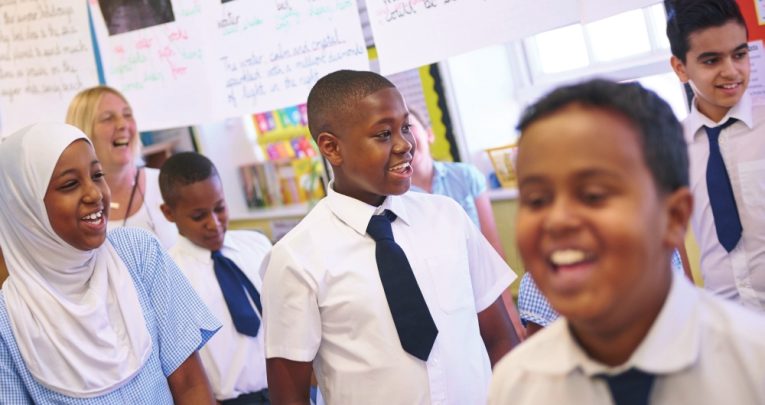“This School Is My Story” – How Staff At Raynham Primary Go The Extra Mile

By supporting families in the community as well as children in the classroom, Marva Rollins has transformed the fortunes of one of London’s most challenging primary schools, says Jacob Stow…

- by Jacob Stow

“When I came here, standards were low – lower than I’d ever seen,” says Marva Rollins, headteacher of Raynham Primary School in Edmonton.
15 years have passed since she arrived, with children’s outcomes improving dramatically under her stewardship, but many of the issues Marva faced when first she took on the role remain. Her commitment to overcoming them explains why she is still in post past the age of retirement.
“Edmonton comes with a lot of in-built challenges, with poverty at the heart of it,” she says. “Our children’s starting point is in the 5% poorest areas in the country, and most are genuinely EAL pupils – not second or third generation immigrants for whom English is their first language.”
Complicating matters, Raynham is a huge and expanding school, with 810 children on roll and an on-site children’s centre with responsibility for a further 130. Space is tight and demand high. The pressure must be relentless, but Marva projects an air of calm and control.
Meeting children’s needs here, we learn, requires a different approach – one that addresses the wider context of their lives, as well as the business of learning itself.
“Schools cannot reverse poverty directly, but they can reduce its impact on children’s life chances,” Marva explains. “Some people say the lines are being blurred, that we’re becoming social workers as well as teachers – we look at it as ‘These are the children, these are the families – this is what they come with, let’s do the best we can’.
‘We meet a lot of their needs, and that reduces referrals to other agencies already under pressure. Not all schools would be willing or able to do that – and of course, some don’t need to. We’re just dealing with the reality here.”
Learning to lead
Rewind to the turn of the century, and the task facing a headteacher at Raynham was daunting. But Marva, a West Indian immigrant, had grown up, taught and led in Newham – a borough with many of the same social and economic issues facing Edmonton.
Those experiences, she says, served her well. “This school is my story,” she explains. “The term ‘hard to reach’ would have described me when I lived in a tower block in Canning Town in the 70s, but I wasn’t hard to reach – I just didn’t know anyone needed to reach me. It’s a term that’s imposed on a community that doesn’t know anyone is interested.
“I’m not saying you have to have been through poverty to understand it, but if you came here having been head of a leafy suburban school, it would be a culture shock. We have 54 languages and people from 38 different countries. We have 50% unemployed and then we have the working poor – I don’t know how well someone from outside that would cope.”
Newham had proved an ideal, if unforgiving training ground for Marva. “My first headship was complex because I was the first black head in the borough,” she explains. “The expression in the school when I arrived was, ‘Well, Newham needed a black head, didn’t it?’ That was my starting point.
‘The deputy had been given a message by the staff to pass on to me when we met: ‘If she comes here, she needs to know she changes for us, because we don’t change for anybody.’ Those attitudes hung in the air as I walked into the school.’
She admits that, “The first 18 months were a nightmare. I don’t think the staff were being malicious, they had just been stuck in a groove. A lot of them had been teaching at the school for 20 or 30 years. They lived round the corner, were close to the local families – why would they want to change? They were a strong, committed group, but committed to each other, so it was very hard to do things differently.
‘The National Curriculum used to come in 12 discrete documents wrapped in cellophane, and those documents were all at the school still in their packaging. This was in 1995!
“I was a bit scared. I’d never been in charge before, but I came to Raynham better prepared as a result of that experience. I don’t think I would have been as successful if it had been my first headship, because I would have been learning too much at once.”
Raising standards
“When I came to Raynham, I knew I needed to act,” Marva reflects. She arrived in Edmonton after five years in Newham – “I couldn’t think of what else I needed to do at that school” – and took charge of a team struggling to provide the education the children needed.
“Reading, writing and maths results were all around 20%,’ she says. ‘50% of children were on the SEN register. The attitude of leadership had been that it wasn’t possible to make a difference because of the high level of special needs, EAL and deprivation. Sometimes people struggle to see beyond the tower blocks and the local context.
‘The expectation is that ‘This is education for the poor’ – that was my experience of going to a secondary modern in Ilford, certainly. For me, it’s about believing that working class children can do well.”
Improving Raynham meant shifting these attitudes from the top down and raising teaching standards. “I went on a course during my first headship and I remember that it was said there are two things that make people successful: one is doing what they love doing, and the other is being monitored,” Marva says. “I had to set the scene very quickly. I was introducing expectations – actually having a bar.
“I had a lot of respect for the staff at the time, as they had gone through a lot of changes and some were very willing to do what the school required of them. But the whole notion of planning and looking at National Curriculum expectations, and assessing children and monitoring was very new to them. After my first two terms, 14 people left – some saying ‘Thank you, I can see what you’re doing, but it’s not for me’; others because I invited them to leave.
“Some staff from my previous school came to join me, but we had a few years of revolving doors with people coming in and out of the school; we had to recruit from overseas. Today it’s much better. I have the strongest leadership team imaginable. You would need to meet them to understand their energy – they drive me crazy some days! And not only them, the middle managers are full of ideas too. It’s taken a while to get to this point, though.”
Boosting attainment
The energy Marva speaks about is evident in classroom practice at Raynham, and in the willingness of staff to go the extra mile to make a difference.
For example, in order to raise standards from their often low starting points, and in recognition of the prevalence of children with EAL, before- and after-school booster sessions in English and maths have been introduced for children in Y6, while children from Y3 upwards can take advantage of regular reading clubs. For many, the school day stretches from 8am to 4.30pm.
“We realised that quarter to nine and 10 past three was not working for this school,” Marva says. “It isn’t about the quality of teaching, it’s the amount we have to teach and how often we have to teach what needs to be taught. We also give children a lot more homework than other schools, which is a bit of a taboo. But the people who are putting forward the policy of reducing homework are highly unlikely to have grown up in Edmonton or Newham. They come from communities where the starting point is very different.”
During the school day proper, there is a clear focus on speech and language. Deputy headteacher Gina Menon, for one, stresses the importance of developing oracy at Raynham. “If you can’t say it, you can’t write it,” she explains, “so children need to be as fluent as we can make them if they’re to show what they can do by the end of primary.
‘We want them to be confident speakers of English, because that’s a life skill. We started using Talk for Writing about four years ago and saw an immediate, dramatic rise in children’s ability to write clearly and articulate beforehand what they were going to write.”
Weekly grammar seminars have also been instituted, to the benefit of some younger teachers – “Many of them went to school at a time when grammar, punctuation and sentence structure didn’t seem to matter!” Marva says – as well as children getting to grips with a new language. It’s a school-wide approach that’s bringing measurable improvements.
Community support
Because of the challenges facing Raynham’s community, achieving successful academic outcomes is about more than what goes on in the classrooms. Creating the right environment for learning means responding to children’s and families needs in the round.
“We’ve become the hub of this community,” says deputy headteacher, Anna Trott. “That’s also based on the fact that we have a successful children’s centre and a lot of outreach going on. As a school we’re very good at signposting parents, especially our pastoral team.
We may not be able to solve everybody’s problems – we don’t have the power to organise housing, for instance – but what we can do is give advice. We have a good relationship with social services, GPs and mental health specialists. We’ve got all of these outside agencies that we work really closely with. We’re almost like Citizens Advice – parents come to us first with their problems.
“At the same time we have to be vigilant. For every one of the families that come to us, there are three that don’t yet have the confidence or haven’t even realised they need help. We invite parents in and do home visits to allow us to build bridges – not just for nursery or Reception, but for any age group. People can be reluctant to start with, so you have to build up the relationship.”
Sometimes the needs are more fundamental – hungry children, or those in need of new shoes or items of uniform, aren’t best prepared to learn.
As ever, Marva and her team have a pragmatic response. “We work with Greggs – they provide food for all the reading clubs and breakfast clubs,” Marva says. “More comes from food banks – Sharon, our pastoral manager, is our food bank ambassador. On top of that, one of our governors belongs to a charity that every year gives us £5,000, and that’s spent on shoes, uniforms and food for families. We have to be creative.”
Swift action
Because children at Raynham must often make up ground to achieve expected levels by the time they leave KS2, ensuring that impediments to learning are identified and acted upon swiftly is a key consideration for staff. “We do a lot of question by question analysis for the children, rather than saying ‘This child is a 4c, how are going to get him to a 4b?’” Marva says. “That’s where our interventions come in – they take small steps and are very precise.
“We want to make sure teachers don’t end up teaching a class something that the majority of pupils already know,” she explains. “When we analyse results, if we see that a lot of children haven’t got a particular question right on a test, we know it’s a teaching issue. If two or three children have missed it, we know that somewhere there’s a misconception or misconceptions. The person running the intervention can then pull out those pupils and work with them to unpick the problems.”
Meet the staff
Marva Rollins, Headteacher “We have to push our children. It’s often a question of mindset – if the parents don’t know what high expectations look like, those expectations have to come from us.
‘It’s hard work; we’ve never arrived. As Y6 left last year, all our results were in the 90% bracket. Then in comes nursery and Reception and nothing has impacted on their life chances yet.”
Anna Trott, Deputy Headteacher “Not all of our children feel safe in the community, but we provide a wonderful, secure environment. They know when they come here that they can leave whatever it is behind them. That’s the key – then we try to give them the tools they need when they’re not at school. We’ve just had a whole thing about keeping yourself safe and E-safety.”
Gina Menon, Deputy Headteacher “We have dozens of children in before and after school for the maths and English booster sessions – by Y6, the children are more independent and often come into school by themselves. We find that by Y5 the English really starts to kick in, and we see quite a sharp rise in reading and writing skills.”
Ozgen Pastirmacioglu, Y4 teacher “Our grammar seminars take place once a week for half an hour. Whole year groups will be in the hall with their whiteboards and we have a flip chart at the front. There are grammar activities, punctuation and tense games, and more. The children aren’t split up by ability – it gives them an opportunity to be together, and addresses things they should be able to do.”
Pupil voice
Reading stars “Reading Stars is a club that we have. We go to the library to read books and do activities. I wanted to join because I like reading books. My favourite book is Friend or Foe by Michael Morpurgo.”
Grammar lessons “We have grammar lessons – they’re every Monday for everyone in Y4. I enjoy them and I’ve got better at grammar. I wasn’t great at spelling before, but I’m learning more English words. I want to be a doctor.”
The baby project “We’ve been doing a baby project; each class in Y4 has been given a baby doll that we have to look after at lunchtime and breaktime. You have to be careful with babies – you don’t want to break their arms.”
Children’s University “When you’re in Y5, going into Y6, you’re given a passport for activities. Each day you do an activity out of school and you fill it in. If you do enough you get to go to the ‘Children’s University’ [graduation] at Middlesex University.”
For more information, visit www.raynhamprimaryschool.co.uk









